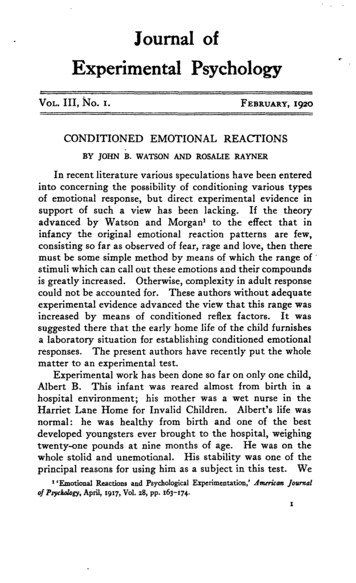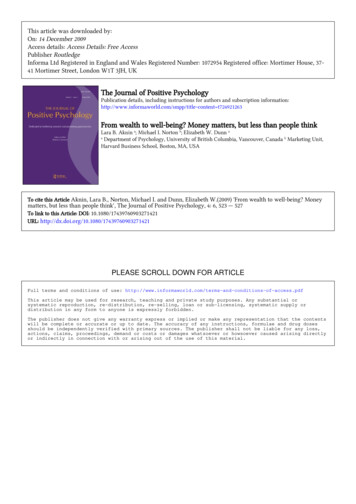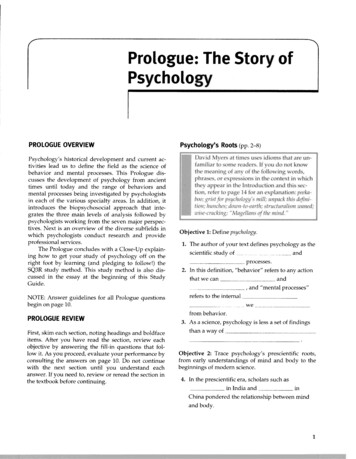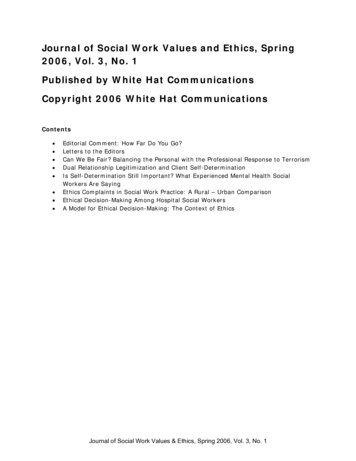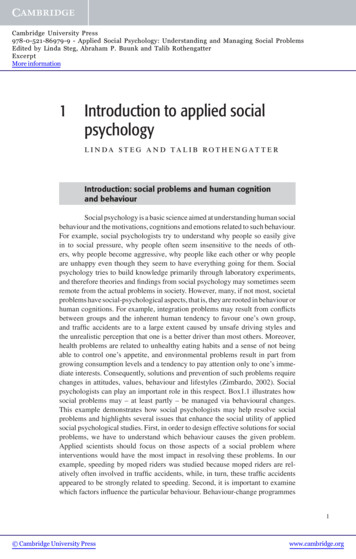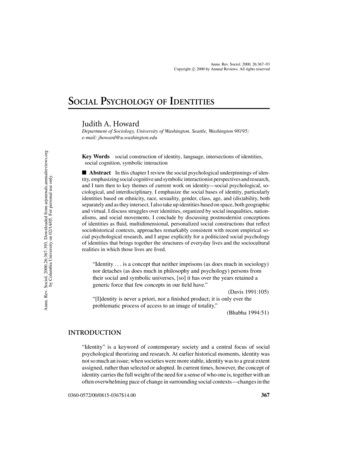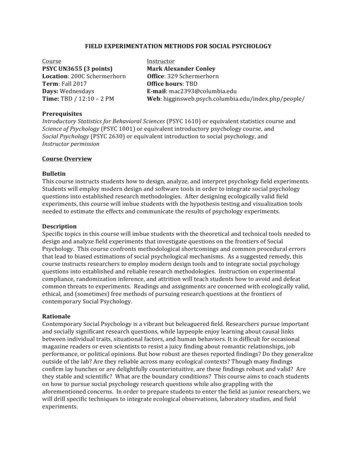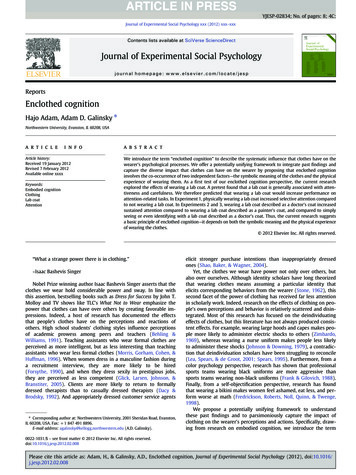
Transcription
YJESP-02834; No. of pages: 8; 4C:Journal of Experimental Social Psychology xxx (2012) xxx–xxxContents lists available at SciVerse ScienceDirectJournal of Experimental Social Psychologyjournal homepage: www.elsevier.com/locate/jespReportsEnclothed cognitionHajo Adam, Adam D. Galinsky ⁎Northwestern University, Evanston, IL 60208, USAa r t i c l ei n f oArticle history:Received 19 January 2012Revised 7 February 2012Available online xxxxKeywords:Embodied cognitionClothingLab coatAttentiona b s t r a c tWe introduce the term “enclothed cognition” to describe the systematic influence that clothes have on thewearer's psychological processes. We offer a potentially unifying framework to integrate past findings andcapture the diverse impact that clothes can have on the wearer by proposing that enclothed cognitioninvolves the co-occurrence of two independent factors—the symbolic meaning of the clothes and the physicalexperience of wearing them. As a first test of our enclothed cognition perspective, the current researchexplored the effects of wearing a lab coat. A pretest found that a lab coat is generally associated with attentiveness and carefulness. We therefore predicted that wearing a lab coat would increase performance onattention-related tasks. In Experiment 1, physically wearing a lab coat increased selective attention comparedto not wearing a lab coat. In Experiments 2 and 3, wearing a lab coat described as a doctor's coat increasedsustained attention compared to wearing a lab coat described as a painter's coat, and compared to simplyseeing or even identifying with a lab coat described as a doctor's coat. Thus, the current research suggestsa basic principle of enclothed cognition—it depends on both the symbolic meaning and the physical experienceof wearing the clothes. 2012 Elsevier Inc. All rights reserved.“What a strange power there is in clothing.” Isaac Bashevis SingerNobel Prize winning author Isaac Bashevis Singer asserts that theclothes we wear hold considerable power and sway. In line withthis assertion, bestselling books such as Dress for Success by John T.Molloy and TV shows like TLC's What Not to Wear emphasize thepower that clothes can have over others by creating favorable impressions. Indeed, a host of research has documented the effectsthat people's clothes have on the perceptions and reactions ofothers. High school students' clothing styles influence perceptionsof academic prowess among peers and teachers (Behling &Williams, 1991). Teaching assistants who wear formal clothes areperceived as more intelligent, but as less interesting than teachingassistants who wear less formal clothes (Morris, Gorham, Cohen, &Huffman, 1996). When women dress in a masculine fashion duringa recruitment interview, they are more likely to be hired(Forsythe, 1990), and when they dress sexily in prestigious jobs,they are perceived as less competent (Glick, Larsen, Johnson, &Branstiter, 2005). Clients are more likely to return to formallydressed therapists than to casually dressed therapists (Dacy &Brodsky, 1992). And appropriately dressed customer service agents⁎ Corresponding author at: Northwestern University, 2001 Sheridan Road, Evanston,IL 60208, USA. Fax: 1 847 491 8896.E-mail address: agalinsky@kellogg.northwestern.edu (A.D. Galinsky).elicit stronger purchase intentions than inappropriately dressedones (Shao, Baker, & Wagner, 2004).Yet, the clothes we wear have power not only over others, butalso over ourselves. Although identity scholars have long theorizedthat wearing clothes means assuming a particular identity thatelicits corresponding behaviors from the wearer (Stone, 1962), thissecond facet of the power of clothing has received far less attentionin scholarly work. Indeed, research on the effects of clothing on people's own perceptions and behavior is relatively scattered and disintegrated. Most of this research has focused on the deindividuatingeffects of clothes, but this literature has not always produced consistent effects. For example, wearing large hoods and capes makes people more likely to administer electric shocks to others (Zimbardo,1969), whereas wearing a nurse uniform makes people less likelyto administer these shocks (Johnson & Downing, 1979), a contradiction that deindividuation scholars have been struggling to reconcile(Lea, Spears, & de Groot, 2001; Spears, 1995). Furthermore, from acolor psychology perspective, research has shown that professionalsports teams wearing black uniforms are more aggressive thansports teams wearing non-black uniforms (Frank & Gilovich, 1988).Finally, from a self-objectification perspective, research has foundthat wearing a bikini makes women feel ashamed, eat less, and perform worse at math (Fredrickson, Roberts, Noll, Quinn, & Twenge,1998).We propose a potentially unifying framework to understandthese past findings and to parsimoniously capture the impact ofclothing on the wearer's perceptions and actions. Specifically, drawing from research on embodied cognition, we introduce the term0022-1031/ – see front matter 2012 Elsevier Inc. All rights reserved.doi:10.1016/j.jesp.2012.02.008Please cite this article as: Adam, H., & Galinsky, A.D., Enclothed cognition, Journal of Experimental Social Psychology (2012), doi:10.1016/j.jesp.2012.02.008
2H. Adam, A.D. Galinsky / Journal of Experimental Social Psychology xxx (2012) xxx–xxx“enclothed cognition” to designate the systematic influence ofclothes on the wearer's psychological processes and behavioraltendencies.Enclothed cognitionTraditional theories of cognition argue that cognitive representations are based on amodal, abstract content. In contrast, theoriesof embodied cognition (e.g., Barsalou, 1999, 2008; Glenberg, 1997;Niedenthal, Barsalou, Winkielman, Krauth-Gruber, & Ric, 2005)argue that cognitive representations are based on modal, perceptualcontent that is based in the brain's sensory systems for perception(e.g., vision, audition), action (e.g., movement, proprioception),and introspection (e.g., mental states, affect). As physical experiences become schematized into multimodal representations storedin memory, these physical experiences form an integral part inshaping cognitive representations of abstract concepts and acquiresymbolic meaning. Thus, physical experiences can trigger associatedabstract concepts and mental simulation through this symbolicmeaning.An increasing amount of research supports the embodied cognition perspective: for example, the physical experience of cleansingoneself is associated with the abstract concept of moral purity(Zhong & Liljenquist, 2006). Because of this symbolic meaning, ithas been shown that physical cleansing influences judgmentsof morality (Schnall, Benton, & Harvey, 2008). In a similar vein,experiencing physical warmth increases feelings of interpersonalwarmth (Williams & Bargh, 2008), walking slowly activates the stereotype of the elderly (Mussweiler, 2006), nodding one's head whilelistening to a persuasive message increases one's susceptibility topersuasion (Wells & Petty, 1980), holding a pen in the mouth in away that activates the muscles associated with smiling leads tomore intense humor responses (Strack, Martin, & Stepper, 1988),carrying a heavy clipboard increases judgments of importance(Jostman, Lakens, & Schubert, 2009), clean scents increase the tendency to reciprocate trust and to offer charitable help (Liljenquist,Zhong, & Galinsky, 2010), and adopting an expansive body postureaffects one's sense of power and associated action tendencies—more so than being in a powerful role (Huang, Galinsky, Gruenfeld,& Guilory, 2011).We argue that just like physical experiences, the experience ofwearing clothes triggers associated abstract concepts and their symbolic meanings. In particular, we posit that wearing clothes causespeople to “embody” the clothing and its symbolic meaning. Consequently, when a piece of clothing is worn, it exerts an influence onthe wearer's psychological processes by activating associated abstractconcepts through its symbolic meaning—similar to the way in which aphysical experience, which is, by definition, already embodied, exertsits influence.Although embodied cognition and enclothed cognition thus operate in similar ways, there is an important difference. In embodiedcognition, the link between a physical experience and its symbolicmeaning is direct, as it is the physical experience itself that carriesthe symbolic meaning. In other words, the symbolic meaning is always automatically embodied because it directly stems from thephysical experience. In enclothed cognition, the link between a physical experience and its symbolic meaning is indirect, as it is theclothes that carry the symbolic meaning. In other words, the symbolicmeaning is not automatically embodied because it stems from theclothes—so it is not realized until one physically wears and thusembodies the clothes.This distinction between embodied cognition and enclothed cognition indicates that enclothed cognition involves the co-occurrenceof two independent factors: the symbolic meaning of the clothesand the physical experience of wearing the clothes. Hence, we propose a basic principle of enclothed cognition—the effects of clothingon people's psychological processes depend on both a) the symbolicmeaning of the clothes and b) whether people are actually wearingthe clothes.Overall, we hypothesize that wearing a piece of clothing and embodying its symbolic meaning will trigger associated psychologicalprocesses. It should be noted that there is an important distinctionto be made between enclothed cognition and material primingeffects. Material priming refers to the phenomenon that simplybeing exposed to a physical item (e.g., a boardroom table) can increase behaviors consistent with the symbolic meaning of that item(e.g., a competitive orientation) (Kay, Wheeler, Bargh, & Ross,2004). We argue, however, that actually wearing a piece of clothingand having the accompanying physical experiences (e.g., seeing iton one's body, feeling it on one's skin, etc.) will make it significantlymore likely for the piece of clothing to influence the wearer's psychological processes, above and beyond basic material priming effects.That is, embodying the clothing's symbolic meaning is a criticalelement in our enclothed cognition perspective.Our argument is consistent with work showing that people whotake the perspective of a stereotyped group are significantly morelikely to display stereotype-consistent behaviors than people whoare merely primed with a stereotyped group (Galinsky, Wang, &Ku, 2008). It is also consistent with research showing that embodying power by adopting an expansive body posture is significantlymore likely to influence power-consistent action tendencies thanmerely priming power (Huang et al., 2011). Just as the effects ofperspective-taking and embodied power are not reducible to abasic behavioral priming process, we propose that the effects ofenclothed cognition are not reducible to simple material primingeffects.Experimental overviewIn the current research, we tested our enclothed cognition perspective with respect to lab coats. Lab coats are the prototypical attire of scientists and doctors. Wearing a lab coat thus signifies ascientific focus and an emphasis on being careful and attentive—attributes that involve the importance of paying attention to thetask at hand and not making errors. To confirm that people indeedassociate a lab coat with attention-related concepts, we recruited38 people (16 female, 22 male; average age: 36.47 years) fromAmazon's Mechanical Turk website (see Buhrmeister, Kwang, &Gosling, 2011) to participate in a short online survey. Participantswere shown a picture of a white lab coat similar to the one usedin the experiments reported in this article. Participants rated theextent to which they associated the lab coat with attentiveness,carefulness, responsibility, and a scientific focus on a scale from 1(not at all) to 5 (very much). An association was considered toexist if it was rated significantly above the midpoint of the scale(see Galinsky & Moskowitz, 2000). Results confirmed that participants held strong associations between a lab coat and each of theattention-related constructs, all ts 5.36, ps b .001. We thus hypothesized that wearing a lab coat increases performance on attentionrelated tasks.In the current research, we explored two dimensions of attention:selective attention and sustained attention. Selective attention is theability to focus on relevant stimuli and ignore irrelevant ones, andsustained attention is the ability to maintain focus on a continuousactivity (Davies, Jones, & Taylor, 1984). Experiment 1 tested whetherwearing a lab coat influences selective attention using a Stroop task(Stroop, 1935). Experiments 2 and 3 looked at sustained attentionusing a comparative visual search task (Pomplun, Reingold, & Shen,2001).Across the experiments, we tested our core hypothesis thatenclothed cognition depends on two independent factors—actuallywearing the clothes and the symbolic meaning of the clothes. InPlease cite this article as: Adam, H., & Galinsky, A.D., Enclothed cognition, Journal of Experimental Social Psychology (2012), doi:10.1016/j.jesp.2012.02.008
H. Adam, A.D. Galinsky / Journal of Experimental Social Psychology xxx (2012) xxx–xxxExperiment 1: physically wearing a lab coatMethodDesign and participantsFifty-eight undergraduates (41 females, 19 males; average age:20.29 years) at a large university in the Midwestern United Statesparticipated in the experiment. They were randomly assigned toone of two conditions: wearing a lab coat vs. not wearing a labcoat.Procedure and experimental manipulationIn the wearing-a-lab-coat condition, participants were asked towear a disposable white lab coat. To provide a cover story, the experimenter told participants that other participants in prior sessions ofthis experiment had been wearing lab coats during lab construction.Although
Please cite this article as: Adam, H., & Galinsky, A.D., Enclothed cognition, Journal of Experimental Social Psychology (2012), doi:10.1016/ j.jesp.2012.02.008 “enclothed cognition” to designate the systematic influence of clothes on the wearer's psychological processes and behavioral tendencies. Enclothed cognition Traditional theories of cognition argue that cognitive representa-tions .
